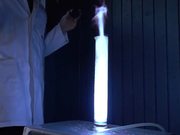An Interesting Experiment - Barking Dog Reaction
The "Barking Dog" is an exothermic chemical reaction that results from the ignition of a mixture of carbon disulfide and nitrous oxide.
This is a reaction between carbon disulfide and nitrous oxide. The equation for this reaction is: carbon disulfide reacts with nitric oxide, which releases carbon dioxide, nitrogen and sulfur, which is then deposited on the walls of the cylinder and which is very inconvenient to wash off. The reaction is very beautiful, during which a bright flash occurs, and the so-called dog barking. Therefore, this experiment is called a barking dog. Before the invention of camera flashes, this reaction often has been used as the illuminator for photography.
_______________________________________________________
Barking dog reaction (Wikipedia):
The "Barking Dog" is an exothermic chemical reaction that results from the ignition of a mixture of carbon disulfide and nitrous oxide.
It has been known for centuries; in 1853, Justus von Liebig was using the bright blue flash and the distinctive ‘woof’ sound of the demonstration to enthrall his students.
In simple terms, the ‘Barking Dog’ reaction is a combustion process, in which a fuel (carbon disulfide, CS2) reacts with an oxidizing agent (nitrous oxide, N2O), producing heat and elemental sulfur. The flame front in the reaction is a zone of very hot, luminous gas, produced by the reactants decomposing.
8 N2O + 4 CS2 → S8 + 4 CO2 + 8 N2

